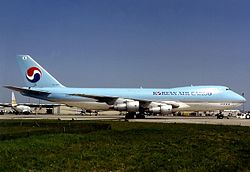Korean Air Cargo Flight 8509
 HL7451, the 747 involved in the accident, in 1992. | |
| Accident | |
|---|---|
| Date | 22 December 1999 |
| Summary | Crashed after take off due to pilot error caused by instrument failure compounded by poor CRM |
| Site | Great Hallingbury, England, United Kingdom 51°51′23″N 0°12′59″E / 51.85639°N 0.21639°E[1] |
| Aircraft | |
| Aircraft type | Boeing 747-2B5F |
| Operator | Korean Air Cargo |
| IATA flight No. | KE8509 |
| ICAO flight No. | KAL8509 |
| Call sign | KOREAN AIR 8509 |
| Registration | HL7451 |
| Flight origin | Gimpo International Airport, Seoul, South Korea |
| 1st stopover | Tashkent International Airport, Tashkent, Uzbekistan |
| 2nd stopover | London Stansted Airport, England, United Kingdom |
| Destination | Milan Malpensa Airport, Milan, Italy |
| Occupants | 4 |
| Crew | 4 |
| Fatalities | 4 |
| Survivors | 0 |
Korean Air Cargo Flight 8509 was a
The aircraft
The aircraft involved was a 19-year-old
INU failure and failed repair
Following the plane's departure from
At Stansted, the engineers who attempted to repair the ADI did not have the correct Fault Isolation Manual available and did not repair or replace the faulty number 1 INU. One of them identified and repaired a damaged connecting plug on the ADI. When the ADI responded correctly to its "Test" button, they believed the fault had been corrected, although this button only tested the ADI and not the INU. The ADI's input selector was left in the normal position.[2]
Flight crew
The flight crew consisted of:
- 57-year-old Captain Park Duk-kyu (M-R: Pak Tŭkkyu)
- 33-year-old First Officer Yoon Ki-sik (M-R: Yun Kishik)
- 38-year-old Flight Engineer Park Hoon-kyu (M-R: Pak Hun'gyu)
- 45-year-old maintenance mechanic Kim Il-suk (
The captain was a former colonel and pilot in the Republic of Korea Air Force and a highly experienced airman,[8] with a total of 13,490 flying hours – 8,495 of which were accumulated flying Boeing 747s. The first officer, in contrast, was relatively inexperienced with just 195 hours of flying experience on the 747 and a total of 1,406 flight hours. The flight engineer, like the captain, had a lot of experience flying 747s – 4,511 out of his 8,301 total flight hours were accrued in them. The maintenance mechanic had been involved with the failed INU repair.[8]
Flight

It was dark when the plane took off from
Aftermath
After the investigation, the United Kingdom's Air Accidents Investigation Branch (AAIB) issued recommendations to Korean Air to revise its training program and company culture, to promote a more free atmosphere between the captain and the first officer.[8] The first recommendation of the AAIB's final accident report was that:
Korean Air continue to update their training and Flight Quality Assurance programmes, to accommodate Crew Resource Management evolution and industry developments, to address issues specific to their operational environment and ensure adaptation of imported training material to accommodate the Korean culture.[2][1]
In popular culture
A March 2012 episode of Mayday also called Air Crash Investigation in the U.K. and the rest of the world (Season 11 Episode 7) titled "Bad Attitude" or "Stansted Crash" investigates this accident.[8]
See also
- Impact of culture on aviation safety
- Air India Flight 855 Another Boeing 747 which crashed under almost identical circumstances almost 22 years prior.
References
- ^ Air Accident Investigation Branch. Retrieved 30 June 2019.
- ^ Air Accident Investigation Branch. June 2003. Archived(PDF) from the original on 8 June 2012. Retrieved 10 July 2011.
- ^ "Korean Air Cargo Flight 8509 incident report". Aviation Safety Network. Retrieved 10 July 2011.
- ^ "HL7451 Korean Air Lines Boeing 747-200". www.planespotters.net. Retrieved 27 June 2020.
- ^ "Korean Air HL7451 (Boeing 747 - MSN 22480)". www.airfleets.net. Airfleets aviation. Retrieved 27 June 2020.
- ^ Byrne, Caroline (23 December 1999). "Korean Air Faces Crackdown After 4 Die In London Crash". The Seattle Times. Associated Press. Retrieved 3 January 2012.
- The Dong-a Ilbo (in Korean). 23 December 1999. Archived from the originalon 2 January 2014.
이 사고로 기장 박득규(朴得圭·57)씨, 부기장 윤기식(尹基植·33)씨, 항공기관사 박훈규(朴薰圭·38)씨, 정비사 김일석(金日奭·45)씨 등 한국인 승무원 4명이 모두 숨졌다. [English: All four Korean crew members died in the accident, including Captain Park Deuk-kyu (박·57), Deputy General Manager Ki-Sik Yoon (33), Aircraft Engineer Park Hun-kyu (朴薰圭·38), and mechanic Kim Il-suk (金日奭·45)]
- ^ a b c d e f g h "Bad Attitude". Mayday. Season 11. Episode 7. March 2012.
External links
- "The AAIB interim report" – BBC – Friday 24 December 1999 (Archive)
- "AAIB Bulletin S2/2000 SPECIAL." Air Accidents Investigation Branch (Archive)
- Cockpit Voice Recorder transcript and accident summary
- Boeing Expresses Condolences After Korean Air Crash – Boeing (Archive)
- Boeing to Assist in Korean Air Investigation – Boeing (Archive)
- "KE-8509 Crash May Be Due to Instrument Failure." – The Chosun Ilbo
- "KAL Team Joins Flight KE-8509 Investigation." – The Chosun Ilbo (Archive)

